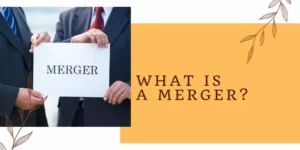Table of Contents
ToggleOverview
When two businesses come together to form a new company, a merger occurs. Types of Mergers, Companies merge to enhance operations, lower competition, gain market share, launch new goods or services, and eventually boost profits.
If you’re thinking about a career in mergers and acquisitions (M&A), a field of corporate law or investment banking that deals with the buying, selling, and incorporation of businesses, you must have a solid understanding of mergers.
What is a Merger?

A merger is a corporate transaction in which two currently operating, independent firms come together to form a single, new legal company. Combinations are voluntary. Both businesses often have an equivalent size and scope and stand to gain from the acquisition.
There are numerous causes for mergers. They might enable each business to expand into new markets, sell new goods, or provide new services. Additionally, they can enhance management, adjust their pricing strategies, or cut their tax obligations. But in the end, businesses combine to enlarge their scope, scale, and income. In other words, mergers enable businesses to increase their revenue.
How a Merger Works?
A merger is the voluntary comingling of two businesses under essentially equal conditions into a single new legal entity. The businesses that agree to join are about similar in size, customer base, and operational scope.
The phrase “merger of equals” is sometimes used to describe this situation. Contrary to mergers, acquisitions typically entail one firm aggressively purchasing another.
The most frequent reasons for mergers are to increase market share, lower operating costs, expand into new markets, bring together similar products, boost revenues, and boost profits—all of which should be advantageous to the firm’s shareholders. Existing shareholders of the two original businesses receive shares in the new company following a merger.
The Merger Fund from Virtus Investment Partners is a mutual fund that was established as a result of a significant number of mergers and offers investors the opportunity to profit from merger deals. The spread, or remaining sum, between the offer price and the trading price, is captured by the fund.
It makes investments in businesses that have made a merger or takeover publicly known. Since its inception in 1989, the fund has averaged 5.8% yearly returns (as of March 31, 2022). To know more about data science training in Chennai
Types of Mergers

There are commonly five types of mergers, which are
- Horizontal merger
- Vertical merger
- Congeneric mergers
- Market-extension or product-extension merger
- Conglomeration
Horizontal Merger
This is one of the main types of mergers. If both merging companies already provide the same goods or services, the merger is seen as horizontal. Companies can lessen competition and gain market dominance through horizontal mergers. For instance, the gas goliath Exxon and the gas goliath Mobil merged in 1998 to establish ExxonMobil. That horizontal transaction valued the new business at $81 billion at the time.
How does it create value?
Greater economies of scale in the market(s) the company participates in are the result of a horizontal merger. The companies can pool production facilities, distribution networks, and human capital, which is likely to cut operating costs.
Example
A well-known instance of a horizontal merger is the 2011 union of HP (Hewlett-Packard) and Compaq. types of acquisition, These two businesses successfully merged to form a leader in global technology with a market value of approximately US$87 billion.
Vertical Merger
If the supply chains of the merging companies overlap, the merger is seen as vertical. Consider a vineyard buying a glass bottle maker or a house construction firm buying a window pane manufacturer. Vertical mergers enable businesses to decrease expenses by eliminating the intermediary. These types of mergers are too common in business.
How does it Create Value?

Lowering costs in the value chain through a vertical merger results in value creation, which can then be transferred to customers to improve the value offer or to shareholders to increase shareholder returns.
Example
In 2000, America Online and Time Warner underwent a noteworthy vertical merger. type of merger, Due to the various supply chain activities of each company—Time Warner provided information through CNN and Time Magazine, while AOL dispersed information via the Internet—the transaction was deemed to be a vertical merger.
Cogeneric Merger
When two businesses that operate in the same industry and serve the same clientele unite, it is referred to as a cogeneric merger. Cogeneric mergers, commonly referred to as product extension mergers, enable businesses to market additional products.
How does it create value?
Although cost synergies are a side benefit, revenue synergies are the primary way that the product expansion merger adds value. The key value proposition, in this case, is that the merger will provide both businesses with enormous prospects for cross-selling. Also read about data science institute in Delhi
Example
A catering firm merging with a party-organizing company is an illustration of a concentric merger. They both operate in the same sector, have various offerings, and offer connected goods or services.
After the two firms merged to establish The Kraft Heinz Company in 2015, Types of Mergers, well-known ketchup producer H. J. Heinz Co. was able to profit from The Kraft Foods Group’s well-liked macaroni and cheese (and vice versa).
Market Extension Merger

A horizontal merger known as a “market extension merger” enables two businesses that sell the same product to enter a new market. A market extension merger might occur, for instance, if a regional bank in the East and a regional bank in the West joined to establish the U.S. Bank of the East and West. By growing their business, these consolidations assist corporations in generating more money.
How does it create value?
Value is primarily produced through revenue synergies in the market extension merger. Additionally, Types
of Mergers, the nations may be able to share some technological synergies. Cost synergies are typically smaller in this situation because businesses will continue to conduct the majority of their operations in each nation even after the merger.
Example
The 2002 market-extension merger between RBC Centura and Eagle Bancshares Inc. aided RBC in expanding its activities in the North American market. One of Atlanta’s largest banks, Tucker Federal Bank, operated by Eagle Bancshares, had over 250 employees and $1.1 billion in assets.
Conglomerate Merger
If the merging businesses have little to no in common from a business standpoint and operate in different industries, Types of Mergers, the merger is regarded as a conglomerate purchase. Imagine a merger between a manufacturer of snack foods and a clothing retailer. Cross-selling opportunities, expanded market potential, and improved operational efficiencies are made possible by conglomerate mergers.
How Does It Create Value?
Whisper it, but experts increasingly agree that the merger itself doesn’t produce much value; rather, Types of Mergers, each of the firms’ successful management, which would have occurred without the merger, is what creates value. Both parties may benefit from a larger consolidated financial sheet and the increased advantages it delivers.
Example
The Walt Disney Company and the American Broadcasting Company (ABC) merged to form a conglomerate. Types of Mergers, The Walt Disney Company is a business in the entertainment industry, whereas the American Broadcasting Company is a media and news business in the US.
What Is a SPAC Merger?
A special-purpose acquisition company (SPAC) merger often occurs when a publicly traded SPAC raises funds to acquire an operational business through the public markets. The operational company combined with SPAC, became a publicly traded business.
What is a Reverse Merger?
When a private corporation buys a publicly traded company, it is referred to as a reverse merger or reverse takeover (RTO). In 2006, Archipelago Holdings and the New York Stock Exchange (NYSE) conducted a reverse merger.
Advantages of the Types of Mergers
Here are some benefits of the types of mergers
- They can accelerate growth. As we previously noted, mergers assist businesses in launching new goods or entering new markets, frequently more affordably or effectively than they could do on their own.
- They assist businesses in achieving economies of scale. In other words, mergers help businesses grow to a size and scale that results in cost savings – sort of like the commercial equivalent of buying in bulk.
- Since they are essentially pooling their funds and resources, they allow businesses access to finance. Types of Mergers, Combining businesses have the option of combining operations, which would increase their revenue.
Disadvantages of the Types of Mergers
Here are some limitations of the types of mergers
- They take a lot of time and money. Before two companies may merge, there are many steps that both parties must do and fund. Mergers are complicated legal operations.
- They cause stress. Mergers can have an impact on employee performance, turnover, and management since they are frequently accompanied by layoffs or significant changes to the workplace culture.
- They frequently don’t work out. A merger might go awry in a number of different ways. For instance, Types of Mergers, antitrust laws apply to them. If the federal government was worried the new company would create a monopoly and reduce competition in the market, it may take legal action to reject the acquisition.
Conclusion
A transaction in which one company purchases another is the simplest definition of an acquisition. Types of Mergers, However, as this article demonstrates, that transaction might take on a variety of shapes and have a variety of underlying objectives. The basic forms and purposes of this transaction are countless. Future articles in our M&A series will concentrate on the stages of mergers to better understand the processes from planning to appraisal to integration.
Understanding these can help you determine whether your corporate growth strategy sufficiently addresses the long-term objectives of your organization.
Frequently Asked Questions
What are the types of horizontal and vertical mergers?
In types of mergers, Mergers are frequently categorized as horizontal or vertical. A vertical merger happens when two companies in various stages of production combine to form a single company, as opposed to a horizontal merger, which happens when two competing companies combine to form a single company.
What is the most common types of mergers?
Vertical mergers are easy to do and frequent. Combining two businesses that offer comparable or shared goods or services is done in an effort to bring together various supply chain operations that either organization may engage in.
What are the features of the merger?
In a Types of mergers, the parties are of comparable stature, size, and operational scope. The target company is smaller and less financially stable than the acquiring company. The power amongst the involved firms has been diluted. The acquiring business controls the acquired one intrinsically.
What is called a horizontal merger?
In types of mergers, A horizontal merger is a merger or corporate restructuring involving businesses in the same sector. Because there is typically more competition among businesses in the same industry, combining businesses can result in significantly bigger synergies and possible market share gains.
What are the objectives of mergers?
Companies look to merge in order to expand their client bases and market reach, lessen competition, and obtain economies of scale. Depending on their goals and plans, businesses might use a types of mergers tactics.













